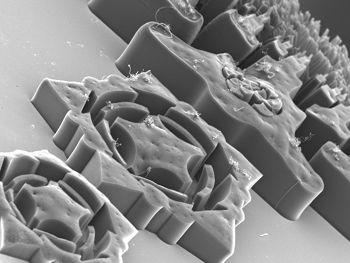This is an image of a carbon nanotube structure (or "architechure") grown by chemical vapor deposition on a silicon substrate, by John Hart, a post-doctoral associate at MIT. Architectures are formed by self-organization of carbon nanotubes as they grow upward from a silicon substrate and a catalyst layer. If the catalyst is uniformly distributed, nanotubes grow everywhere on the substrate. How the nanotubes organize is defined by how they "push" and "pull" each other to produce the architectures. If the catalyst is only located in certain areas (patterned), then nanotubes grow only in those areas. In this image, the catalyst is patterned by photolithography, where a light-sensitive polymer is used to specify where the catalyst is placed.
Each structure consists of thousands to millions of parallel nanotubes (the density of nanotubes growing from a substrate is about 20 billion per square centimeter). The star-shaped patterns in "starship" are approximately one millimeter wide.
The image was taken using a scanning electron microscope.
Many such images, which are displayed at www.nanobliss.com, resemble everyday objects and macroscopic landscapes; however, these structures are formed by self-assembly interactions at much smaller scales.
So far, most of these images have arisen as results of normal experiments, but in some cases John took a bit more time to image the sample in the microscope, or to refine or add color to the image afterwards. John says he's still very much a scientist, but is seeing now how artistic endeavors can enhance the presentation and visualization of science, and how laboratory techniques such as fabrication and self-assembly can be a new art form.
Courtesy of and Copyright © Anastasios John Hart. Permission to reprint required.
To learn more, visit John's website and his research page
Look for the series at the Nanotechnology Now Gallery soon.
Each structure consists of thousands to millions of parallel nanotubes (the density of nanotubes growing from a substrate is about 20 billion per square centimeter). The star-shaped patterns in "starship" are approximately one millimeter wide.
The image was taken using a scanning electron microscope.
Many such images, which are displayed at www.nanobliss.com, resemble everyday objects and macroscopic landscapes; however, these structures are formed by self-assembly interactions at much smaller scales.
So far, most of these images have arisen as results of normal experiments, but in some cases John took a bit more time to image the sample in the microscope, or to refine or add color to the image afterwards. John says he's still very much a scientist, but is seeing now how artistic endeavors can enhance the presentation and visualization of science, and how laboratory techniques such as fabrication and self-assembly can be a new art form.
Courtesy of and Copyright © Anastasios John Hart. Permission to reprint required.
To learn more, visit John's website and his research page
Look for the series at the Nanotechnology Now Gallery soon.











No comments:
Post a Comment